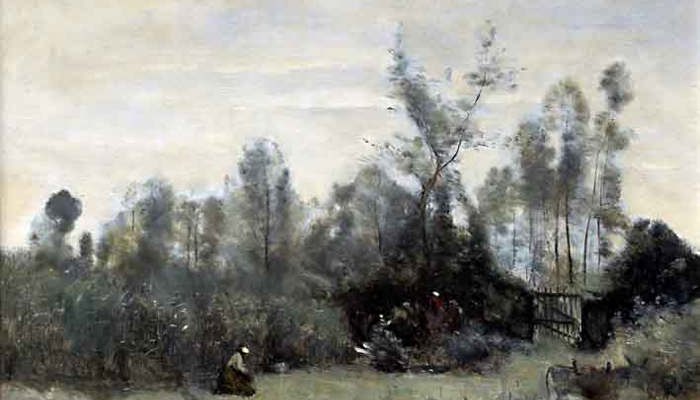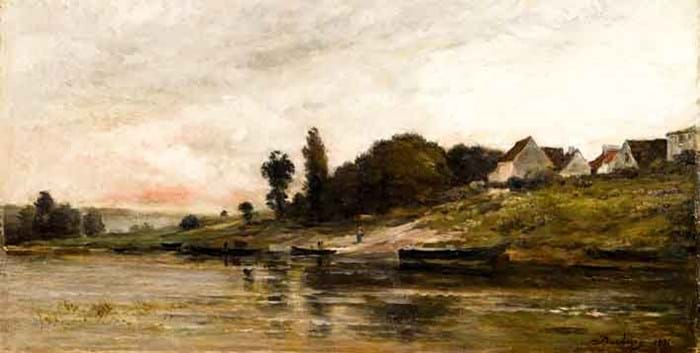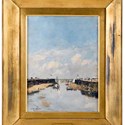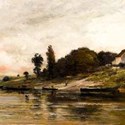The time capsule was opened with predictable fireworks on March 30. The 63 pictures sold without a failure for a premium-inclusive $4.3m (£2.7m), well above the estimate of $1.2m-1.9m.
George D. Horst was a Pennsylvania businessman - a partner in a hosiery manufacturer in Reading, Pennsylvania that became the second largest in North America. Across a relatively short period of time between 1911 and the Wall Street Crash of October 1929, he used his wealth to assemble a considerable art collection for the fledgling Reading Public Museum.
However, in 1924, upset when a new building was sited outside the city limits on land donated by his principal business competitor, he demanded his pictures back and instead, two years later, built a private gallery in woods close to his home.
Horst died in 1934 and his wife in 1957. By that time many of the pictures they had collected had fallen out of fashion and into critical disrepute. As a result, the paintings, and their gallery concealed amongst the Douglas firs and the blue pines of Sheerlund Forest, were largely forgotten by the Horst family until the 1980s when George H. Sullivan (a specialist in Roman architecture) began to re-examine his grandfather's legacy.
Dual Identity
As an immigrant from Germany, the near 50-50 blend of American and European paintings in the collection reflected Horst's dual identity. Some of the most valuable pictures in the collection were by the New Hope School and the group of American artists known as The Ten - many of them purchased soon after exhibition at the National Academy of Design in New York or the Pennsylvania Academy of the Fine Arts.
However, the event that first piqued Mr Sullivan's interest had been an exhibition he attended in Manhattan dedicated to the Barbizon painter Charles Daubigny (1817-78). As he studied his grandfather's Daubigny, then more closely the rest of the ensemble, he discovered that this seemingly unpretentious collection, including Venetian potboilers and merry cardinals, was also studded with trophy names of 19th century French art.
Some of them, the forerunners of Impressionism, represented the very peak of East Coast collecting fashion when his forebear frequented the auction rooms of New York City.
Most of the pictures were in excellent original condition, retained their original frames and were meticulously documented by original bills of sale and exhibition/auction catalogues stored in a room above the gallery.
Economics of Taste
There were to be some subtle lessons in the history - and the economics - of taste.
At 'The Public Sale of the Crocker, Newcomb, Moir and Bonner Collections' held by the American Art Association (a precursor of Parke-Bernet) in New York in 1912, Horst had paid $8000 for his Daubigny, a 13in x 2ft 2in (34 x 67cm) oil on panel of a pink-tinged river landscape at sunset titled Bord de L'Oise, Le Soir and dated 1874.
It was a great deal of money at the time (in 1913 a Ford Model T cost $550) and amply illustrates the high regard in which the Barbizon school was held by American collectors in the ante-bellum. That almost a century later it was estimated at just $6000-10,000 reflected both the art market's sometimes cruel roller coaster - and the generally conservative reserves set throughout this sale. Nonetheless, in very good overall condition save some small areas of retouching, it did rather better, selling at $40,000 (£25,160) to the French trade.
At the same sale in 1912 Horst had paid a relatively modest $400 for Eugène Louis Boudin's (1824-98) 14 x 10in (35 x 26cm) oil on panel of sailboats and lighthouses in an estuary.
This small-scale 'plein air' work painted in Trouville in 1891 - a typical combination of sun-dappled sea and cloud-filled blue sky punctuated by brightly-hued shipping - is today far more commercial than Daubigny's more academic palette of greens and browns. It was also in excellent original condition. A British dealer, who had seen the picture when highlights from the collection were put on view in Pall Mall, bought it at $140,000 (£88,050), some distance above its $40,000-60,000 estimate. In all, collectors from 47 countries registered for the sale.
Corot Landscape
Horst had bought his Jean-Baptiste-Camille Corot (1796-1875) for $6000 at The Anderson Galleries, New York, in 1928, by which time the price of a Model T had fallen to $450. It was part of a sale titled Important Paintings by Old & Modern Masters collected by the late Charles H. Senff where the Metropolitan Museum of Art also purchased a Corot.
This 13 x 18in (33 x 46cm) oil by the father of Barbizon painting in a handsome giltwood frame depicted a wooded landscape - doubtless somewhere in the Fontainebleau forest or the surrounding regions of Bas-Breau, Ville-d'Avray and Jean-de-Paris - populated by a lone figure. A garden gate to the right foreground gave the work its title. In excellent condition apart from relining and a minor area of craquelure, it tipped over the top estimate to bring $100,000 (£62,890) from a Philadelphia private buyer.
The buyer's premium was 25/12%.
A full report of the sale features in this week's printed copy of ATG.











